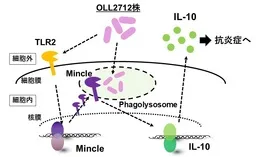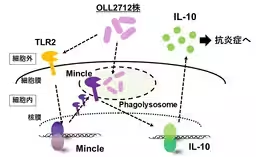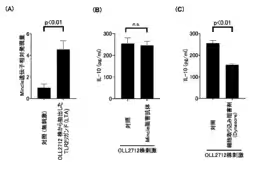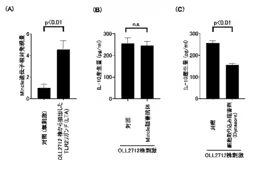

The Mechanism of Lactiplantibacillus Plantarum OLL2712 Inducing IL-10 Production Revealed
Overview of Research on Lactiplantibacillus Plantarum OLL2712
Recent studies have pinpointed the mechanisms through which the probiotic Lactiplantibacillus plantarum OLL2712 enhances sugar and fat metabolism by inducing the production of interleukin-10 (IL-10) from immune cells. This landmark research was presented at the 2025 Annual Meeting of the Japanese Society of Lactic Acid Bacteria.
Background
Lactiplantibacillus plantarum OLL2712, owned by Meiji Holdings Co., Ltd., has shown promising results in its ability to stimulate the immune system to produce the anti-inflammatory substance, IL-10. Co-researchers from Osaka University, including Professor Akira Yamazaki, and Kyoto University, Professors Shigenobu Kishino and Jun Ogawa, conducted this study and published their findings in the prestigious international journal, Microbiology Spectrum, in February 2025.
Dendritic cells, which are a type of white blood cell, play a crucial role in the immune system by recognizing external substances and conveying their information to other immune cells to initiate an appropriate response. OLL2712 is capable of triggering these cells to produce IL-10 through specific receptors, revealing a direct link between this probiotic strain and immune response enhancement.
Key Findings
The research uncovered specific mechanisms involved in IL-10 production:
1. Receptor Involvement: The production of IL-10 was found to be dependent on two receptors: TLR2 and Mincle.
2. Elicitation Mechanism: The presence of OLL2712 was confirmed to induce the expression of Mincle through its recognition by TLR2.
3. Recognizing OLL2712: Once the OLL2712 enters the dendritic cells, Mincle recognizes it, leading to a surge in IL-10 production.
Practical Applications of Research Outcomes
By scientifically substantiating the remarkable properties of OLL2712, Meiji aims to secure trust in its products. The next step involves exploring which component of OLL2712 specifically interacts with the identified receptors, paving the way for enhanced health products that capitalize on these findings.
Purpose of the Study
Selected from over 6,000 strains in Meiji's milk lactic acid bacteria library based on its ability to induce IL-10 production, OLL2712 has previously demonstrated effects in reducing chronic inflammation to improve sugar and fat metabolism when incorporated into yogurt. Understanding how OLL2712 facilitates IL-10 production has been a significant focus of this research.
Study Methodology
The research team utilized cultured dendritic cells to examine the influence of OLL2712 and specific receptor ligands on IL-10 production. Through antibody-mediated inhibition studies and tests inhibiting Mincle gene expression and internal uptake of OLL2712, they explored the impact of these molecules and processes on IL-10 output.
Key Results:
- - When TLR2 was inhibited, the production of IL-10 decreased. However, stimulation with TLR2 ligands alone was insufficient for IL-10 production, indicating that TLR2 activation is necessary but not solely sufficient.
- - Suppressing the expression of Mincle significantly reduced IL-10 production, confirming its role in recognizing OLL2712. Additionally, the coordinated stimulation of TLR2 and Mincle was found to enhance IL-10 production further.
- - The team proposed a recognition sequence where OLL2712 might be first recognized by TLR2, subsequently inducing Mincle's expression.
- - Even though inhibiting Mincle on the cell surface did not change IL-10 production, reducing OLL2712 uptake by dendritic cells led to decreased IL-10 levels, suggesting Mincle’s role in recognizing internalized OLL2712.
Discussion
This research significantly clarifies the cooperative activation role of Mincle and TLR2 in the IL-10 production process via OLL2712, asserting that the cellular recognition order and localization also impact overall immune response. While previous findings highlighted the metabolic benefits of OLL2712, this study advances understanding of the underlying mechanisms contributing to these health advantages.



Topics Health)










【About Using Articles】
You can freely use the title and article content by linking to the page where the article is posted.
※ Images cannot be used.
【About Links】
Links are free to use.